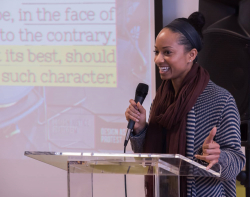Michele Crawford - Increasing the Architecture Pipeline
 African-Americans who say that they work in the field of architecture and engineering are few. The Department of Labor cites that forty years ago, there were approximately 50,000 architects in the United States. Of that number, two percent, or roughly 1,000 architects were black.
African-Americans who say that they work in the field of architecture and engineering are few. The Department of Labor cites that forty years ago, there were approximately 50,000 architects in the United States. Of that number, two percent, or roughly 1,000 architects were black.
The percentage of African-American architects has not changed much in 40 years. According to the Bureau of Labor Statistics, in 2016, African-American architects and engineers boast only five percent. The ACE Mentoring program is helping to increase that percentage and Michele Crawford is contributing to that growth.
Every other week, for the past three years, Crawford serves as a mentor in Max Hayes High School’s ACE Mentoring Program. This year there are 18 students that seek her and the mentor team’s guidance while working on this year’s Request For Proposal, Vital Neighborhoods, which explores methods to improve sustainability of vacant lots.
At Robert P. Madison Architecture firm, where she is a project designer, Crawford participates in various phases of the design process. She enjoys seeing projects progress from conception to construction and enjoys being on site and observing the construction journey. She is currently helping with construction administration at the new Cleveland Heights High School, set to open this fall.
Crawford was encouraged to participate as a mentor with her supervisor, Sandra Madison. “Our firm is a strong supporter of the ACE program,” said Crawford when asked why she became involved. “I appreciate the change of pace that interacting with the students provides. I enjoy learning what life as a teen looks like these days. Spending time, sharing knowledge and encouraging students to think and work collaboratively to develop ideas is also a benefit,” she adds.
Crawford finds that starting each year with an open mind and being flexible to cater to and work with the students is a must. “I appreciate their participation since it’s an afterschool activity. It’s exciting and inspiring that they want to be there and are encouraged to participate. I haven’t been surprised, but volunteering with the ACE Mentoring Program confirms that educational and arts programming beyond school hours is necessary and needed for students, and ACE provides the opportunity for engaged learning at a community based level,” she offers.
Students participating in ACE have an opportunity to work with the latest design tools of the trade. “Last year, our students attempted to work with Sketchup, a 3-D modeling program. We created a tutorial with a few of the students and completed a 3-D massing model. They chose to renovate a church and used the model to help visualize the space program,” she says.

Crawford loves that she has, “The opportunity to share what I do and inspire the next generation of architects. I also love the dedication to promote architecture, engineering and construction careers to high school students. Early exposure to these careers is important,” she says.
As she works to make more students, especially African-Americans, more aware of the field of architecture, Crawford suggests that while high school students are definitely a good target market, it may serve ACE well by introducing the Mentoring Program to students before they reach high school.
“My wish for the ACE Cleveland program includes expanding services to reach younger students. I believe middle school and even elementary aged students would benefit from the program or something similar. The earlier they receive the exposure, the better,” says Crawford. “I would like to see the ACE students entering architecture and design related careers at a higher rate. In our changing world, the face of the architectural profession, specifically, would greatly benefit from increased diversity and ACE is a perfect program to help impact the number of culturally responsible potential candidates,” she continues.

Citing a recent article, Crawford further explains the need to begin exposure sooner. “In the American Institute of Architects Equity, Diversity and Inclusion Commission’s Executive Summary, released in January, it lists engaging children with K-12 architecture programs as a priority recommendation for action,” she says. “The current ACE Program in Cleveland is already committed to this. I wonder if similar programming can be provided to an interested younger audience in the future. That is something I would advocate for!”
When she is not working, or helping expand students’ architectural knowledge, Crawford enjoys travelling to near and far places and taking in the sights of the city. She is also a fan of occasional Netflix binge evenings and chai tea lattes with whip!

